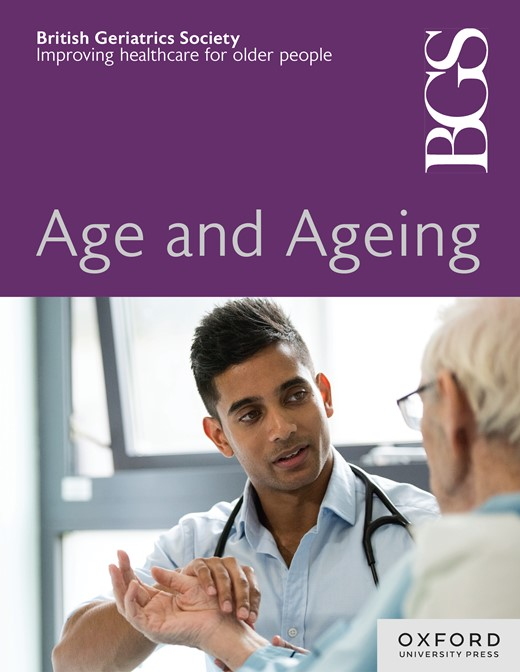Risk of adverse outcomes associated with mirtazapine compared to sertraline use among older people living in long-term care facilities
IF 6
2区 医学
Q1 GERIATRICS & GERONTOLOGY
引用次数: 0
Abstract
Background Antidepressants are used by 60% of residents of long-term care facilities (LTCFs). Mirtazapine and sertraline are the most commonly used antidepressants, despite little safety information for their use in LTCFs. Objective To investigate risk of adverse outcomes (falls, fractures, cardiovascular-, dementia-, and delirium-related hospitalisations, all-cause mortality) associated with mirtazapine compared to sertraline use post-LTCF entry. Design Active new user retrospective cohort study. Subjects Individuals aged 65–105 years entering LTCFs in three Australian states during 1 January 2015 to 31 October 2018, who initiated mirtazapine or sertraline ≤60 days post-LTCF entry, with follow-up to 31 December 2019. Methods The inverse probability of treatment weighting of individuals’ propensity scores was used to adjust Cox and Fine–Gray regression models to estimate the risk of outcomes of interest associated with mirtazapine compared to sertraline use in LTCFs. Weighted (adjusted) hazard ratios (aHRs), subdistribution hazard ratios and 95% confidence intervals (95% CIs) are presented. Results A total of 5409 residents initiated mirtazapine (71%, n = 3837) or sertraline (29%, n = 1572) post-LTCF entry. After weighting, mirtazapine was associated with a higher risk of mortality (aHR 1.16, 95% CI 1.05–1.29) compared to sertraline. The risk of falls and fractures within 90 days was not statistically significantly different between the groups but was lower in mirtazapine users thereafter. No differences in risk of cardiovascular-, dementia- or delirium-related hospitalisations were observed. Conclusions Compared to sertraline, mirtazapine use is associated with a higher risk of mortality and, after 90 days of use, a lower risk of falls and fractures. This risk of harm should be balanced with limited evidence for effectiveness when considering antidepressant therapy in LTCFs.生活在长期护理机构的老年人使用米氮平与使用舍曲林的不良后果风险比较
背景:60%的长期护理机构(ltcf)居民使用抗抑郁药。米氮平和舍曲林是最常用的抗抑郁药,尽管它们在长期慢性阻塞性肺疾病中使用的安全性信息很少。目的:比较ltcf进入后使用米氮平与使用舍曲林的不良结局(跌倒、骨折、心血管、痴呆和谵妄相关住院、全因死亡率)的风险。设计积极的新用户回顾性队列研究。受试者:2015年1月1日至2018年10月31日期间在澳大利亚三个州进入ltcf的65-105岁个体,在ltcf进入后≤60天开始使用米氮平或舍曲林,随访至2019年12月31日。方法使用个体倾向得分治疗加权的逆概率来调整Cox和Fine-Gray回归模型,以估计米氮平与舍曲林在ltcf中使用相关的相关结局风险。给出加权(调整)风险比(aHRs)、亚分布风险比和95%置信区间(95% ci)。结果5409名居民在ltcf后开始使用米氮平(71%,n = 3837)或舍曲林(29%,n = 1572)。加权后,与舍曲林相比,米氮平与更高的死亡风险相关(aHR 1.16, 95% CI 1.05-1.29)。90天内跌倒和骨折的风险在两组之间没有统计学上的显著差异,但此后使用米氮平的患者摔倒和骨折的风险较低。没有观察到心血管、痴呆或谵妄相关住院的风险差异。结论:与舍曲林相比,米氮平的使用与更高的死亡风险相关,并且在使用90天后,摔倒和骨折的风险较低。在考虑抗抑郁药物治疗ltcf时,这种危害风险应与有限的有效性证据相平衡。
本文章由计算机程序翻译,如有差异,请以英文原文为准。
求助全文
约1分钟内获得全文
求助全文
来源期刊

Age and ageing
医学-老年医学
CiteScore
9.20
自引率
6.00%
发文量
796
审稿时长
4-8 weeks
期刊介绍:
Age and Ageing is an international journal publishing refereed original articles and commissioned reviews on geriatric medicine and gerontology. Its range includes research on ageing and clinical, epidemiological, and psychological aspects of later life.
 求助内容:
求助内容: 应助结果提醒方式:
应助结果提醒方式:


